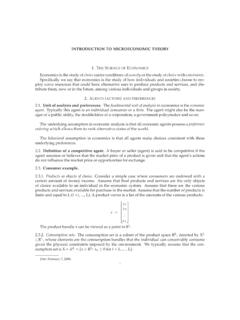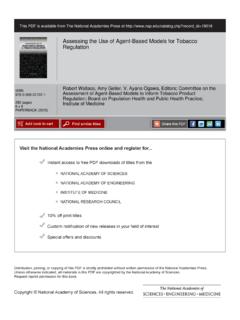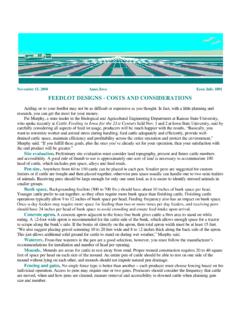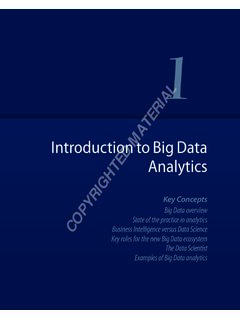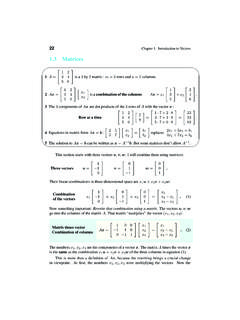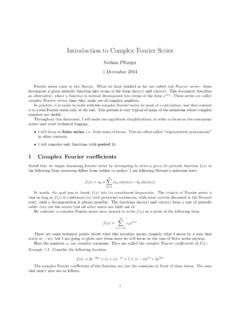Transcription of An Introduction to Neural Networks - Iowa State University
1 May 27, 2002An Introduction to Neural NetworksVincent CheungKevin CannonsSignal & Data Compression LaboratoryElectrical & Computer EngineeringUniversity of ManitobaWinnipeg, Manitoba, CanadaAdvisor: Dr. W. KinsnerCheung/Cannons1 Neural NetworksOutline Fundamentals Classes Design and Verification Results and Discussion ConclusionCheung/Cannons2 Neural NetworksWhat Are Artificial Neural Networks ? An extremely simplified model of the brain Essentially a function approximator Transforms inputs into outputs to the best of its abilityFundamentalsClassesDesignResultsN NInputsOutputsInputsOutputsCheung/Cannon s3 Neural NetworksWhat Are Artificial Neural Networks ? Composed of many neurons that co-operate to perform the desired functionFundamentalsClassesDesignResults Cheung/Cannons4 Neural NetworksWhat Are They Used For?
2 Classification Pattern recognition, feature extraction, image matching Noise Reduction Recognize patterns in the inputs and produce noiseless outputs Prediction Extrapolation based on historical dataFundamentalsClassesDesignResultsCheu ng/Cannons5 Neural NetworksWhy Use Neural Networks ? Ability to learn NN s figure out how to perform their function on their own Determine their function based only upon sample inputs Ability to generalize produce reasonable outputs for inputs it has not been taught how to deal withFundamentalsClassesDesignResultsCheu ng/Cannons6 Neural NetworksHow Do Neural Networks Work? The output of a neuron is a function of the weighted sum of the inputs plus a bias The function of the entire Neural network is simply the computation of the outputs of all the neurons An entirely deterministic calculationNeuroni1i2i3biasOutput = f(i1w1+ i2w2+ i3w3+ bias)w1w2w3 FundamentalsClassesDesignResultsCheung/C annons7 Neural NetworksActivation Functions Applied to the weighted sum of the inputs of a neuron to produce the output Majority of NN s use sigmoid functions Smooth, continuous, and monotonically increasing (derivative is always positive)
3 Bounded range - but never reaches max or min Consider ON to be slightly less than the max and OFF to be slightly greater than the minFundamentalsClassesDesignResultsCheun g/Cannons8 Neural NetworksActivation Functions The most common sigmoid function used is the logistic function f(x) = 1/(1 + e-x) The calculation of derivatives are important for Neural Networks and the logistic function has a very nice derivative f (x) = f(x)(1 - f(x)) Other sigmoid functions also used hyperbolic tangent arctangent The exact nature of the function has little effect on the abilities of the Neural networkFundamentalsClassesDesignResultsC heung/Cannons9 Neural NetworksWhere Do The Weights Come From? The weights in a Neural network are the most important factor in determining its function Training is the act of presenting the network with some sample data and modifying the weights to better approximate the desired function There are two main types of training Supervised Training Supplies the Neural network with inputs and the desired outputs Response of the network to the inputs is measured The weights are modified to reduce the difference between the actual and desired outputsFundamentalsClassesDesignResultsC heung/Cannons10 Neural NetworksWhere Do The Weights Come From?
4 Unsupervised Training Only supplies inputs The Neural network adjusts its own weights so that similar inputs cause similar outputs The network identifies the patterns and differences in the inputs without any external assistance Epoch One iteration through the process of providing the network with an input and updating the network 's weights Typically many epochs are required to train the Neural networkFundamentalsClassesDesignResultsC heung/Cannons11 Neural NetworksPerceptrons First Neural network with the ability to learn Made up of only input neurons and output neurons Input neurons typically have two states: ON and OFF Output neurons use a simple threshold activation function In basic form, can only solve linear problems Limited.
5 2 .8 Inp ut Ne urons Weights Output Neuron FundamentalsClassesDesignResultsCheung/C annons12 Neural NetworksHow Do Perceptrons Learn? Uses supervised training If the output is not correct, the weights are adjusted according to the formula: wnew= wold+ (desired output)* * + 0 * + 1 * = Output Threshold = > Output was supposed to be 0 update the weightsW1new= + 1*(0-1)*1 = + 1*(0-1)*0 = + 1*(0-1)*1 = = 1 FundamentalsClassesDesignResults is the learning rateCheung/Cannons13 Neural NetworksMultilayer Feedforward Networks Most common Neural network An extension of the perceptron Multiple layers The addition of one or more hidden layers in between the input and output layers Activation function is not simply a threshold Usually a sigmoid function A general function approximator Not limited to linear problems Information flows in one direction The outputs of one layer act as inputs to the next layerFundamentalsClassesDesignResultsChe ung/Cannons14 Neural NetworksXOR ExampleInputsOutput01H2:Net = 0( ) + 1( ) = = 1 / (1 + ) = : 0, 1H1:Net = 0( ) + 1( ) = = 1 / (1 + ) = x 10-4O.
6 Net = x 10-4( ) + ( ) = = 1 / (1 + ) = 1 FundamentalsClassesDesignResultsCheung/C annons15 Neural NetworksBackpropagation Most common method of obtaining the many weights in the network A form of supervised training The basic backpropagation algorithm is based on minimizing the error of the network using the derivatives of the error function Simple Slow Prone to local minima issuesFundamentalsClassesDesignResultsCh eung/Cannons16 Neural NetworksBackpropagation Most common measure of error is the mean square error:E = (target output)2 Partial derivatives of the error wrt the weights: Output Neurons:let: j= f (netj) (targetj outputj) E/ wji= -outputi j Hidden Neurons:let: j= f (netj) ( kwkj) E/ wji= -outputi jj = output neuroni = neuron in last hiddenj = hidden neuroni = neuron in previous layerk = neuron in next layerFundamentalsClassesDesignResultsChe ung/Cannons17 Neural NetworksBackpropagation Calculation of the derivatives flows backwards through the network , hence the name, backpropagation These derivatives point in the direction of the maximum increase of the error function A small step (learning rate) in the opposite direction will result in the maximum decrease of the (local) error function.
7 Wnew= wold E/ woldwhere is the learning rateFundamentalsClassesDesignResultsCheu ng/Cannons18 Neural NetworksBackpropagation The learning rate is important Too small Convergence extremely slow Too large May not converge Momentum Tends to aid convergence Applies smoothed averaging to the change in weights: new= old- E/ woldwnew= wold+ new Acts as a low-pass filter by reducing rapid fluctuations is the momentum coefficientFundamentalsClassesDesignResu ltsCheung/Cannons19 Neural NetworksLocal Minima Training is essentially minimizing the mean square error function Key problem is avoiding local minima Traditional techniques for avoiding local minima: Simulated annealing Perturb the weights in progressively smaller amounts Genetic algorithms Use the weights as chromosomes Apply natural selection, mating, and mutations to these chromosomesFundamentalsClassesDesignResu ltsCheung/Cannons20 Neural NetworksCounterpropagation (CP) Networks Another multilayer feedforward network Up to 100 times faster than backpropagation Not as general as backpropagation Made up of three layers: Input Kohonen Grossberg (Output)Inputs Input Layer Kohonen Layer Grossberg Layer Outputs FundamentalsClassesDesignResultsCheung/C annons21 Neural NetworksHow Do They Work?
8 Kohonen Layer: Neurons in the Kohonen layer sum all of the weighted inputs received The neuron with the largest sum outputs a 1 and the other neurons output 0 Grossberg Layer: Each Grossberg neuron merely outputs the weight of the connection between itself and the one active KohonenneuronFundamentalsClassesDesignRe sultsCheung/Cannons22 Neural NetworksWhy Two Different Types of Layers? More accurate representation of biological Neural Networks Each layer has its own distinct purpose: Kohonen layer separates inputs into separate classes Inputs in the same class will turn on the same Kohonenneuron Grossberg layer adjusts weights to obtain acceptable outputs for each classFundamentalsClassesDesignResultsChe ung/Cannons23 Neural NetworksTraining a CP network Training the Kohonen layer Uses unsupervised training Input vectors are often normalized The one active Kohonen neuron updates its weights according to the formula.
9 Wnew= wold+ (input - wold)where is the learning rate The weights of the connections are being modified to more closely match the values of the inputs At the end of training, the weights will approximate the average value of the inputs in that classFundamentalsClassesDesignResultsChe ung/Cannons24 Neural NetworksTraining a CP network Training the Grossberg layer Uses supervised training Weight update algorithm is similar to that used in backpropagationFundamentalsClassesDesign ResultsCheung/Cannons25 Neural NetworksHidden Layers and Neurons For most problems, one layer is sufficient Two layers are required when the function is discontinuous The number of neurons is very important: Too few Underfit the data NN can t learn the details Too many Overfit the data NN learns the insignificant details Start small and increase the number until satisfactory results are obtainedFundamentalsClassesDesignResults Cheung/Cannons26 Neural NetworksOverfittingTrainingTes tW ell fitOverfitFundamentalsClassesDesignResul tsCheung/Cannons27 Neural NetworksHow is the Training Set Chosen?
10 Overfitting can also occur if a good training set is not chosen What constitutes a good training set? Samples must represent the general population Samples must contain members of each class Samples in each class must contain a wide range of variations or noise effectFundamentalsClassesDesignResultsCh eung/Cannons28 Neural NetworksSize of the Training Set The size of the training set is related to the number of hidden neurons Eg. 10 inputs, 5 hidden neurons, 2 outputs: 11(5) + 6(2) = 67 weights (variables) If only 10 training samples are used to determine these weights, the network will end up being overfit Any solution found will be specific to the 10 training samples Analogous to having 10 equations, 67 unknowns you can come up with a specific solution, but you can t find the general solution with the given informationFundamentalsClassesDesignResu ltsCheung/Cannons29 Neural NetworksTraining and Verification The set of all known samples is broken into two orthogonal (independent) sets.
